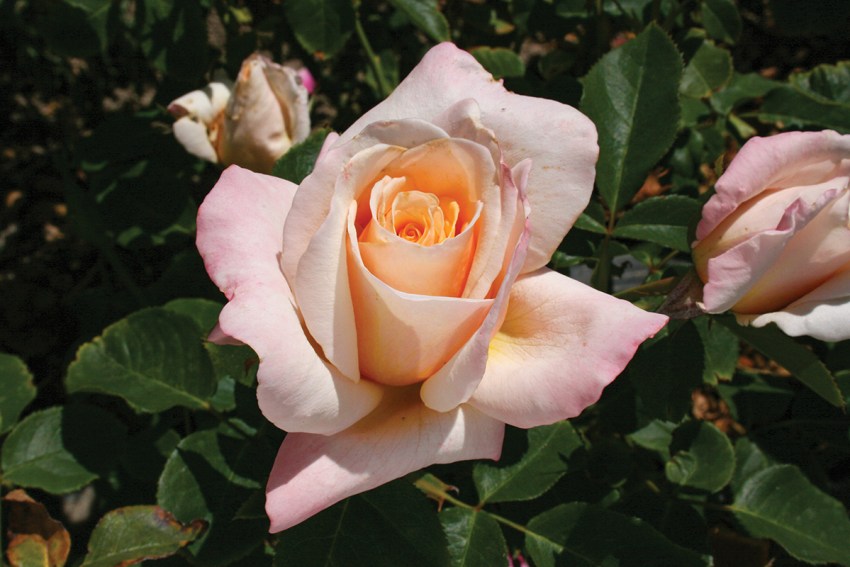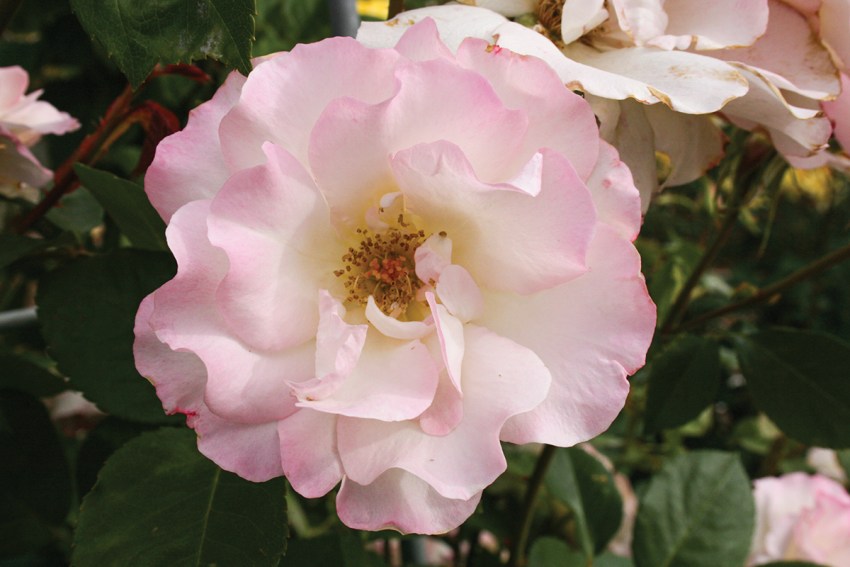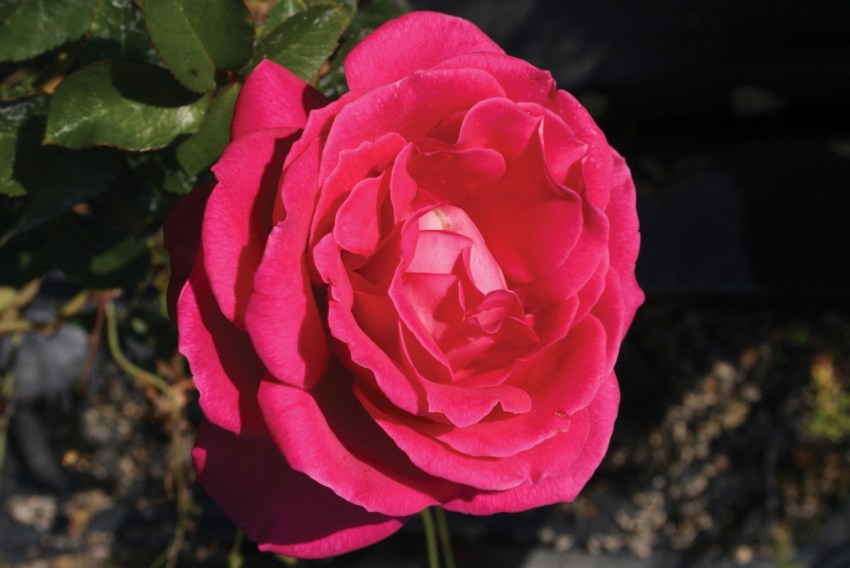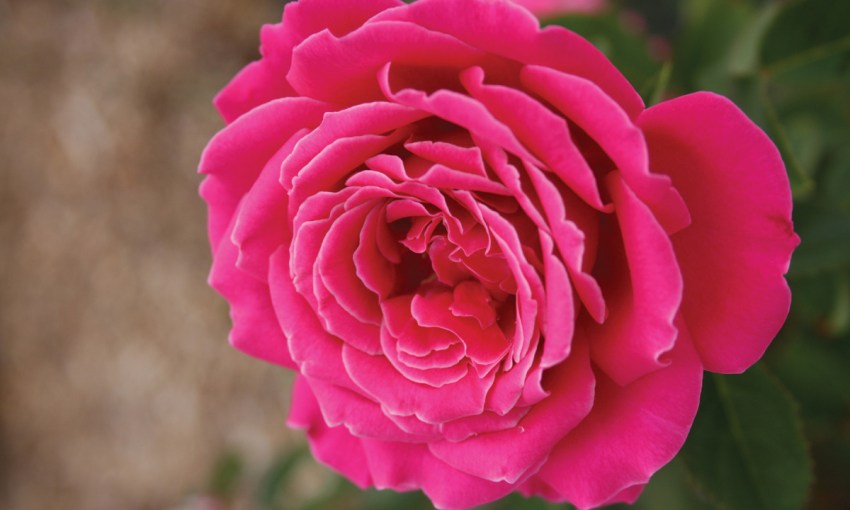You may often admire the beauty of the roses blooming in your garden, but have you ever stopped to ponder their perfume?
Perfumed blooms: Understanding rose scents
Countless bards, composers and writers across the millennia, have spoken, sung and generally waxed lyrical about the romance and allure to be found within a scented rose. As complicated as love, so is a rose’s fragrance.
Whether on a bush, in a vase or beautiful bouquet, the one thing we all seem to do, when greeted by a rose bloom, is to push in our nose and take a big sniff. Sometimes, as is the case with many glasshouse grown roses, there is little if any scent to enjoy. However, for the vast number of roses grown in gardens across South Australia, you are greatly rewarded with a fragrance-filled snout.

Like wine, where aromas are often described with great gusto – the “vibrant berry and plum notes” of a shiraz or the “subtle lemon and peach hints” in a chardonnay – so, too, can a rose’s unique perfume be equally identified to add a new dimension to your gardening experience.
A rose’s scent is produced as a mixture of chemical compounds, known as monoterpenes, within each petal. As these volatile compounds evaporate, the perfume is released and the subsequent level and type of fragrance is very much dependent on that chemical composition. Recent research into rose fragrance has identified a particular enzyme which, if present, allows the production of monoterpenes and is responsible for each variety’s specific perfume.
Some rose species such as Rosa damascena, Rosa gallica and Rosa centifolia produce generous amounts of the highly fragrant essential oil known as attar of rose. This pure rose scent is a valuable ingredient for the global perfume industry, with hundreds of thousands of tonnes of their petals harvested and processed annually.
A number of years ago, perfume company Robertet from the fragrance capital Grasse in Provence, and renowned rose breeding firm, Meilland International, combined their skills and rose plants to create an effective way to identify rose scent.

The Robertet perfumer or “Nose” as they are known, visited the Meilland International rose fields at Le Cannet-des-Maures in the heart of Provence, carefully smelling and re-smelling a suite of rose varieties before categorising them into distinct fragrance groups. Petals from an individual rose within each group were picked and placed in a specially-designed glass chamber, which was heated to a temperature at which the scented oils within each petal evaporated. The fragrant gas was captured, distilled and analysed, via a gas spectrometer, to determine the specific chemical compounds that contributed to that rose’s unique fragrance. This process was repeated for all the selected varieties.
This mix of tradition and science helped identify six key smells or “notes” that form the main elements in a rose scent: rose, fruit, wood, green, floral and spice. For most roses, one note tends to be dominant, with other notes combining to help make up the total perfume.
“Rose” notes are the strongest and sweetest scent. Even in small quantities, attar of rose is an easily identified classic “rose” fragrance, which tends to last longest in the nose and will often overpower many of the other scents. Varieties with a strong rose note include, “Double Delight”, “Fiona’s Wish”, “Best Friend”, “Mr. Lincoln” and “Papa Meilland”.
“Fruit” notes tend to be a sharp, sometimes tangy smells, which are quickly picked up by the nose but are not as strong nor long-lasting as the “rose” note. The “fruit” note includes a range of fruity smells: citrus (lemon, orange) berry (raspberry, strawberry), tropical (mango, passionfruit, banana), apricot and peach. Roses that have a dominant fruit note include, “St. John” (raspberry), “Charles De Gaulle” (lemon), “Michelangelo” (peach).
“Woody” notes include walnut and linseed scents. These are usually quite subtle and identified as the “extra” smell in a fragrance. Which is probably a good thing, who wants a rose ponging like a well-oiled cricket bat?
“Green” notes, provide a very light smell easily identified with the first sniff picking up a range of odours including green apple, cut grass and even crushed leaves. Varieties with a green note are normally classified as lightly fragrant such as “Seduction”.

The “floral” note is different to the “rose” note, as it is generally the background scent and not the dominant note. Verbena, lilac and violet are some of these secondary elements picked up in a fragrance. Roses that include a “floral” note are “The Children’s Rose” (verbena) and “Gift of Grace” (jasmine).
“Spice” notes are often the fragrances people either like or dislike. They include pepper, leatherwood, clove, liquorice and honey and hit the nose quickly. The David Austin Roses that often have a myrrh fragrance are classic spice-scented varieties while “Spirit of Peace” has a distinct leatherwood perfume.
Of course, each person’s olfactory sense can be quite different; some of us have a much keener sense of smell than others. However, using the “six key notes” system can help guide your nose into better identifying the main scents in any bloom.
Find a rose bloom and take a good sniff. Ok, what was the first or dominant note that hit your nose – rose, fruit, wood, green, floral or spice? If you picked up something straight away, well done. If not, take another big sniff. Once you have identified the main note, now challenge yourself to pick up the secondary or underlying notes, this is a little bit trickier, but good fun.
Having the best bloom to smell is very important. Here are some tips for choosing the most aromatic flower:
Select a bloom that has just fully opened, this will provide the best level of scent. Avoid young, immature buds and tired old blooms.

The best fragrance is produced in early afternoon. Recent studies have shown this is better than early morning or late afternoon.
Fragrance is best produced on clear, still days with the temperature over 20C. Try smelling that same bloom on a cold, cloudy and windy day, and you’ll be surprised how little scent you get.
Because rose fragrance is produced from glands on the lower petal surfaces, cup your hands around a bloom then put your nose in to capture the full perfume.
Good fragrance is produced on healthy plants, so keep your roses well fed and watered.
Using these six “key notes” is a novel way to select roses for your garden. Armed with just your nose and these few simple rules, you too can talk up the alluring bouquet, the heady perfume and cheeky bite of your favourite rose variety.
Try it out. You never know, you could be the best “nose” in your neighbourhood.
This story first appeared in the April 2021 issue of SALIFE magazine.



